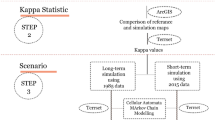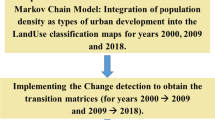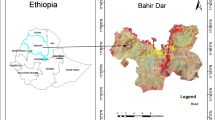Abstract
Urban growth, a dynamic and demographic phenomenon, refers to the increased spatial value of urban areas, such as cities and towns, due to social and economic forces. Nowadays, urban lands are rapidly increasing, replacing non-urban lands such as agricultural, forest, water, rural, and open lands. In this study, a CA-Markov model was utilized to predict the growth of urban lands and their spatial trends in Seremban, Malaysia. The performance of the CA-Markov model was also assessed. The Markov chain model was applied to produce the quantitative values of transition probabilities for urban and non-urban lands. Subsequently, the CA model was used to predict the dynamic spatial trends of land changes. The change in urban and non-urban land use from 1984 to 2010 was modeled using the CA-Markov model for calibration purposes and to compute optimal CA transition rules, as well as to predict future urban growth. For accuracy assessment, the CA-Markov model was validated using a kappa coefficient. An 83% overall accuracy was observed for the kappa index statistics, which indicates the excellent performance of the proposed model. Finally, based on the CA transition rules and the transition area matrix produced from the Markov chain model-based calibration process, the future urban growth in Seremban for 2020 and 2030 was simulated.









Similar content being viewed by others
References
Abdullahi S, Pradhan B (2016) Sustainable brownfields land use change modeling using GIS-Based weights-of-evidence approach. Appl Spat Anal Policy 9:21–38
Abdullahi S, Pradhan B, Mansor S, Shariff ARM (2015) GIS-based modeling for the spatial measurement and evaluation of mixed land use development for a compact city. GISci Remote Sens 52:18–39
Aburas MM, Ho YM, Ramli MF, Ash’aari ZH (2016) The simulation and prediction of spatio-temporal urban growth trends using cellular automata models: a review. Inter J Appl Earth Obs 52:380–389
Aburas MM, Ho YM, Ramli MF, Ash’aari ZH (2017) Improving the capability of an integrated CA-Markov model to simulate spatio-temporal urban growth trends using an analytical hierarchy process and frequency ratio. Inter J Appl Earth Obs 59:65–78
Al-sharif AA, Pradhan B (2013) Monitoring and predicting land use change in Tripoli Metropolitan City using an integrated Markov chain and cellular automata models in GIS. Arab J Geosci 7(10):4291–4301
Al-sharif AA, Pradhan B (2015) Spatio-temporal prediction of urban expansion using bivariate statistical models: assessment of the efficacy of evidential belief functions and frequency ratio models. Appl Spat Anal Policy 9(2):213–231
Alsharif AA, Pradhan B (2014) Urban sprawl analysis of Tripoli Metropolitan city (Libya) using remote sensing data and multivariate logistic regression model. J Indian Soc Remote Sens 42:149–163
Anderson JR (1976) A land use and land cover classification system for use with remote sensor data. US Government Printing Office
Ballestores F Jr, Qiu Z (2012) An integrated parcel-based land use change model using cellular automata and decision tree. Proceedings Intern Acad Ecol Environ Sci 2:53–69
Barredo JI, Kasanko M, McCormick N, Lavalle C (2003) Modelling dynamic spatial processes: simulation of urban future scenarios through cellular automata. Landsc Urban Plann 64:145–160
Batty M, Longley PA (1994) Fractal cities: a geometry of form and function. Academic Press, London
Bihamta N, Soffianian A, Fakheran S, Gholamalifard M (2014) Using the SLEUTH urban growth model to simulate future urban expansion of the Isfahan Metropolitan Area, Iran. J Indian Soc Remote Sens 43:407–414
Celio E, Koellner T, Grêt-Regamey A (2014) Modeling land use decisions with Bayesian networks: spatially explicit analysis of driving forces on land use change. Environ Model Softw 52:222–233
Clarke (1997) A self-modifying cellular automaton model of historical. Environ Plan B 24:247–261
Coppedge BR, Engle DM, Fuhlendorf SD (2007) Markov models of land cover dynamics in a southern Great Plains grassland region. Landsc Ecol 22:1383–1393
Couclelis H (1985) Cellular worlds: a framework for modeling micro—macro dynamics. Environ Plan A 17(5):585–596
Couclelis (1997) From cellular automata to urban models: new principles for model development and implementation. Environ Plann: Plann Des 24:165–174
DOSM (2011) Statistics Yearbook. Department of Statistics Malaysia 3:367–381
Doygun H (2009) Effects of urban sprawl on agricultural land: a case study of Kahramanmaraş, Turkey. Environ Monit Assess 158:471–478
Economic Planning Unit M (2013) Economic History of Malaysia. Economic Planning Unit, Malaysia
Epsteln J, Payne K, Kramer E (2002) Techniques for mapping suburban sprawl. Photogramm Eng Remote Sens 63:913–918
Guan D, Li H, Inohae T, Su W, Nagaie T, Hokao K (2011) Modeling urban land use change by the integration of cellular automaton and Markov model. Ecol Model 222:3761–3772
Inouye CEN, de Sousa WC, de Freitas DM, Simões E (2015) Modelling the spatial dynamics of urban growth and land use changes in the north coast of São Paulo, Brazil. Ocean Coas Manag 108:147–157
Maithani S (2009) A neural network based urban growth model of an Indian city. J Indian Soc Remote Sens 37:363–376
Mohammad M, Sahebgharani A, Malekipour E (2013) Urban growth simulation through cellular automata (CA), anaiytic hierarchy process (AHP) and GIS; case study of 8th and 12th Municipal Districts of Isfahan 8:57-70
Muller MR, Middleton J (1994) A Markov model of land-use change dynamics in the Niagara Region, Ontario, Canada. Landsc Ecol 9:151–157
Pijanowski BC, Brown DG, Shellito BA, Manik GA (2002) Using neural networks and GIS to forecast land use changes: a land transformation model. Comput Environ Urban Syst 26:553–575
Punia M, Singh L (2012) Entropy approach for assessment of urban growth: a case study of Jaipur, India. J Indian Soc Remote Sens 40:231–244
Ren P, Gan S, Yuan X, Zong H, Xie X (2013) Spatial expansion and sprawl quantitative analysis of Mountain City built-up area. In Geo-Informatics in Resource Management and Sustainable Ecosystem. Springer:166–176
Santé I, García AM, Miranda D, Crecente R (2010) Cellular automata models for the simulation of real-world urban processes: a review and analysis. Landsc Urban Plann 96:108–122
Sudhira H, Ramachandra T, Jagadish K (2004) Urban sprawl: metrics, dynamics and modelling using GIS. Inter J Appl Earth Obs 5:29–39
Sun H, Forsythe W, Waters N (2007) Modeling urban land use change and urban sprawl: Calgary, Alberta, Canada. Netw Spat Econ 7:353–376
Tobler WR (1979) Cellular geography. Philosophy in geography. Springer, Dordrecht, pp 379–386
Tran TV (2008) Research on the effect of urban expansion on agricultural land in Ho Chi Minh City by using remote sensing method 24:104-111
Verburg PH, Soepboer W, Veldkamp A, Limpiada R, Espaldon V, Mastura SS (2002) Modeling the spatial dynamics of regional land use: the CLUE-S model. Environ Manag 30:391–405
Wagner DF (1997) Cellular automata and geographic information systems. Environ Plann 24:219–234
Wang J, Maduako IN (2018) Spatio-temporal urban growth dynamics of Lagos Metropolitan Region of Nigeria based on Hybrid methods for LULC modeling and prediction. Eur J Remote Sen 51:251–265
Wang S, Zheng X, Zang X (2012) Accuracy assessments of land use change simulation based on Markov-cellular automata model. Procedia Environ Sci 13:1238–1245
White R, Engelen G (1994) Cellular dynamics and GIS: modelling spatial complexity. Geogr Syst 1(3):237–253
White R, Engelen G (2000) High-resolution integrated modelling of the spatial dynamics of urban and regional systems. Comput Environ Urban Sys 24:383–400
White R, Engelen G, Uljee I (1997) The use of constrained cellular automata for high-resolution modelling of urban land-use dynamics. Environ Plann B Plann Des 24(3):323–343
White R, Engelen G, Uljee I, Lavalle C, Ehrlich D (2000) Developing an urban land use simulator for European cities. In: Proceedings of the Fifth EC GIS Workshop: GIS of Tomorrow. European Commission Joint Research Centre, Stresa, pp 179–190
Wu F (1998) SimLand: a prototype to simulate land conversion through the integrated GIS and CA with AHP-derived transition rules. Inter J Geogr Inf Sci 12:63–82
Yang X, Zheng X-Q, Lv L-N (2012) A spatiotemporal model of land use change based on ant colony optimization, Markov chain and cellular automata. Ecol Model 233:11–19
Yeh AG-O, Li X (2001) Measurement and monitoring of urban sprawl in a rapidly growing region using entropy. Photogrammetric Eng Remote Sens 67:83–90
Zhang Q, Ban Y, Liu J, Hu Y (2011) Simulation and analysis of urban growth scenarios for the Greater Shanghai Area, China. Comput Environ Urban Sys 35:126–139
Funding
The study presented here is the part of research project funded by Universiti Putra Malaysia (UPM) under grant No. 9448100.
Author information
Authors and Affiliations
Corresponding author
Additional information
Responsible Editor: Amjad Kallel
Rights and permissions
About this article
Cite this article
Aburas, M.M., Ho, Y.M., Pradhan, B. et al. Spatio-temporal simulation of future urban growth trends using an integrated CA-Markov model. Arab J Geosci 14, 131 (2021). https://doi.org/10.1007/s12517-021-06487-8
Received:
Accepted:
Published:
DOI: https://doi.org/10.1007/s12517-021-06487-8




